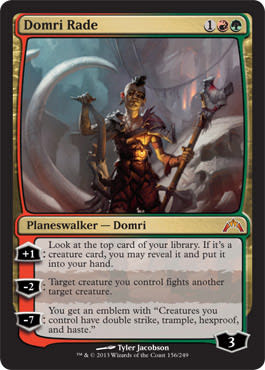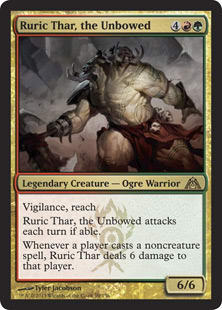Join Twitter this week if you aren’t already addicted to the medium. God knows I am.
This is the week when you will find the active Magic artists among the thousands of artists because their annual awards are this week. These are the people you want to follow because they interact with fans and they objectively make great art. Beyond the altering artists like Randy (RK) Post and Steve Argyle, this is where you get you see the sketches, the process, and the artists puffing their chests out when their art is mentioned in high esteem.
For an art-interested Magic player, this is one of the biggest times of the year.
You will want to watch at least these people on Twitter:
- Steve Argyle – @Steve_Argyle
- Aleksi Briclot – @AleksiBriclot
- Brom – @GeraldBrom
- Eric Deschamps – @DeschampsArt
- Lucas Graciano – @LucasJGraciano
- Michael C. Hayes –@Michael_C_Hayes
- Terese Nielsen – @TNielsenArt
- David Palumbo – @dave_palumbo
- rk post – @postrk
- Cynthia Sheppard – @SheppardArts
The reason you want to follow them is that their names were listed as inclusions into the Spectrum Fantastic Art Annual 20, which releases to the public this week. While Brom probably doesn’t have a Magic card in, the others all potentially could. Brom’s a bit too big for Magic now, and frankly, he doesn’t tweet much. Conversely, Cynthia Sheppard is growing her social-media presence and blowing up like I thought she would.
What is fun to do is find the new artists who got in and you didn’t know have an online presence. Theros brought in a lot of new folks, so this week is a perfect time to find out who they are. This still begs the question: what the hell is Spectrum?
What Is Spectrum?
I talk about Spectrum every now and then, but I haven’t really explained what it is. They have a mission, a reason for doing this:
Spectrum is a yearly book, an annual that has really impressive fantasy and science fiction art included within its pages. In the era before the Internet, it showed art directors who is doing incredible work and allowed for art students to see current examples of what the market is doing. It’s a reference guide, art competition, contemporary art-trend guide, and coffee-table book all in one.
To be included in the annual, you need to submit your art by late January of every year, with a submission fee. The cost is $20 per illustration or $40 for a series of artworks. A series would be up to five images that connect somehow—like a comic book, gallery showcase, or the like. Basically, you have to have incredible foresight to submit $100 worth of art with no direct payoff as a straight expense for your freelance art-making business. If you’re lucky, you create some amazing works, and Wizards of the Coast submits your art for you. Bonus!
Most other “art books” have compilations of what is considered “good” but not a strict jury-chosen process, and they’re certainly not able to be printed every year. This book has the best art directors, artists, critics, and agents in the illustration business sit on the jury. If you’ve heard an artist “name” such as Donato Giancola, Rebecca Guay, or Todd Lockwood, those people are the types who sit on the jury.
The Spectrum Fantastic Art Annual is shortened to Spectrum when talking to people.
In addition to the book, a convention is held every May in Kansas City: Spectrum Fantastic Art Live. This May of 2014 will be its third year. I go every year. If you’re there, I’m always up for grabbing some barbecue-burnt-end sandwiches with folks.
Significance of Spectrum
If you’ve “made it into Spectrum,” you’ve hit a milestone as an artist.
Not unlike winning any work-related award, there is definitely a separation of pre-Spectrum and post-Spectrum work. Immediately upon making it into this book, your status as an artist rises. You can charge more for commissions. Prints of the included artwork can be significantly more expensive.
As I’ve said before, Eric Deschamps really propelled himself into a lot of work when he placed his Spectrum artwork on the back of his business cards. He then got a few planeswalkers. I’m not saying it’s linear, but it’s noticed when folks make it into the “unpublished” category. For Wizards, a few Japanese companies can pay higher commissions, but no one can give the kind of exposure a Magic-related image can do for a career due to the marketing juggernaut and the fervor of the fan base. No game can touch that, and Hasbro stockholders also know it.
Wizards hasn’t raised its commission rate for illustrations in years, but it has increased the amount of artworks submitted, at $20 a pop. The advertising potential is enormous for a company and changes lives if you’re an artist. So, it’s kind of a fun addition for Magic artists who are quite good. That status allows Wizards to say, “We only want the best artists,” and on the other end, if you’re amazing, there are hundreds of artists below you who are also talented, so rates won’t increase.
How Magic Stacks Up
Magic has had roughly sixty-five inclusions into the annual, through Spectrum 19. I have a hard time including all the Duels of the Planeswalkers images, promotional art, and other associated comics and such as “Magic art” in there, but the more the merrier.
How this stacks up to other brands is pretty easy. Magic submits a batch of art on behalf of artists, and other gaming companies don’t. So, you don’t see a ton of World of Warcraft, Netrunner, or Applibot illustrations make it into Spectrum. Are they objectively worse or do they simply not invest $400 in raising their artist and brand profiles in the greater market? Maybe it’s a little of A and a little of B.
Some general rules of thumb for the Magic block of submissions are listed below in no particular order. All images below are inclusions in Spectrum annuals over the years.
All planeswalkers are generally submitted:
 |
 |
Big-time legendary creatures or mythics are often submitted:
 |
 |
There will always be some oddball commons, which are beautiful, that are submitted:
 |
 |
Fat Pack images are always submitted:

Promotional images are always submitted. You know when they announce a new set? It’s that art.

Novel covers used to be submitted, but novels no longer exist.

If you want to know each Spectrum inclusion, year by year, please visit here.
A few community Vorthos members keep the list up to date with OriginalMagicArt.com serving as an archival resource for the art.
Spectrum 20, INCOMING!
These three we already know are in!
Of these three, Ruric Thar, the Unbowed by Tyler Jacobson, was a finalist in the “Institutional” category for the Spectrum. Each section has a “best of,” including advertising, book, comics, concept art, dimensional, editorial, institutional, and unpublished. Magic has never had a finalist until Tyler’s artwork. This is a huge, huge deal. Magic came from humble beginnings, and now it’s being considered to have some of the best art in a given year.
Fantasy art is still considered the weird cousin in the fine-art world, but efforts like Spectrum make it more accepted, exhibited, and sought out by collectors, raising its aesthetic value internationally. If Magic were to ever have a serious art exhibition, while showing the Alphas would be fun for players, showing the Spectrum pieces would probably provide a higher-quality experience and raise the illustrations into finer art. I’d start with them and have a short run, say a week, with Magic tournaments each night selling prints. I’m just saying: If a Seattle small art gallery wanted to show the Magic-included pieces in the newest annual book, which number at least ten, normally in the tweens or twenties, it could be an incredible, high-touch marketing event. God knows I’d be there, and I’d like to think if we have good enough sandwiches, you’d stop by, too.
The full listing of Spectrum 20 will be coming from me this week. You’ll see just pictures and saying who made it with medium. I might add if an original art, if traditional, is available too.
Until then!
- Mike
























